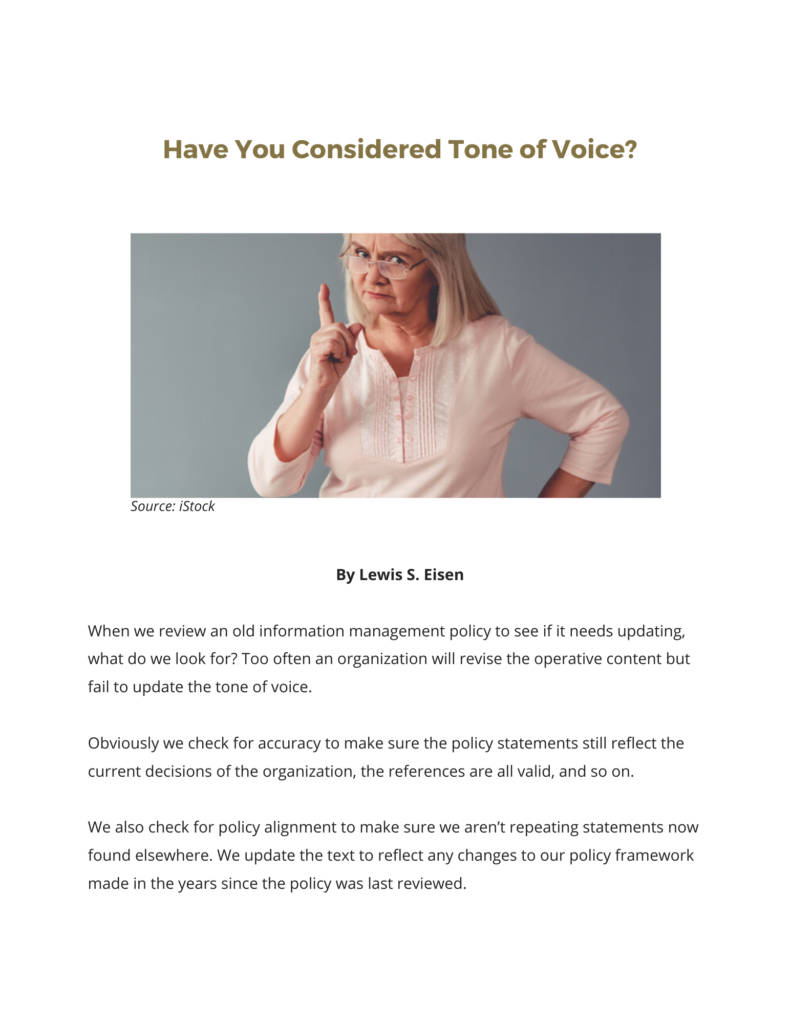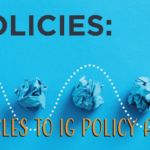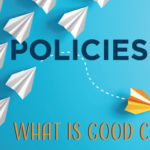Have You Considered Tone of Voice?

When we review an old information management policy to see if it needs updating, what do we look for? Too often an organization will revise the operative content but fail to update the tone of voice.
Obviously we check for accuracy to make sure the policy statements still reflect the current decisions of the organization, the references are all valid, and so on.
We also check for policy alignment to make sure we aren’t repeating statements now found elsewhere. We update the text to reflect any changes to our policy framework made in the years since the policy was last reviewed.
In addition, we review the vocabulary to update terminology where necessary. Many words that were used a certain way years ago have since acquired new scope. Sometimes the change is so gradual that we may not immediately realize the word had a different meaning when the policy was written. As an example, the term “messages” once referred to voice messages left on an answering machine, to short notes about telephone calls scrawled on little pink slips of paper, and to basic instant messaging services sent through local area networks. Today it includes not only electronic mail, but also text sent through the chat features of sites like LinkedIn and Twitter, and through systems like SMS on your smart phone.
Most people are relatively thorough when checking old policy documents for potential problems in those three areas. Policy writers do their best to strive for “clear and concise.”
But what about updating the tone of voice to make it appropriate for today’s workforce?
If you’ve read my article “How to Break the Mold of Negativity Around IM Policies,” then you know I’m a big proponent of wording policy statements — in all corporate support areas, including IM — in a way that doesn’t sound like angry parents scolding naughty children. Examples of this old-style tone of voice are statements that open with gambits like “Employees must always” or “It is expected that,” and those that end with a wagging finger, such as “will not be tolerated,” “is unacceptable,” and the terse sentence “No exceptions will be permitted.”
The dictatorial tone of voice — so common in the policy instruments we inherit from our corporate predecessors — is a vestige of a time when a command-and-control hierarchy was considered the paragon of organizational management structures, a time when the men in charge (and they were mostly men) made pronouncements that the workers were expected to follow without question.
Years ago, that tone of voice was standard in communications coming from upper management to rank-and-file employees. People spoke that way and wrote that way. The I-am-in-charge-and-you-will-obey-me style never raised an eyebrow.
Today’s workplace is not the command-and-control autocracy it was in days past. Today’s workplace is a collaborative, consensus-building, diversity-respecting, egalitarian, and non-discriminatory environment where employers try to create and maintain a culture of respect.1 As part of this culture, progressive managers have learned to communicate more respectfully to employees. Even the people who use bossy language in their written policies don’t use that same wording when they speak directly to others in the organization.
Whether it was appropriate in the past is a question for social historians, but clearly it is outdated today. In the “Breaking the Mold” article, I pointed out that many penal codes don’t even use such harsh language. Legislation, too, is written in a neutral tone.
So why do so many people continue to compose new policies in the old tone of voice?
True, written language evolves more slowly than spoken language, but there’s more to it than that. Tone of voice has a generational dimension.
As a baby boomer, I still remember the days when questioning authority was considered a mark of disrespect. Not only were people given rules in an aggressive tone of voice, such as “We will not tolerate tardiness,” but they were expected not to speak back. When I entered the workforce, even the mere observation that that tone of voice might be inappropriate would have made people laugh out loud.
Baby boomers learned how to make rules from their parents and their teachers. Once grown up, even if the boomers as parents started out speaking to their Generations X and Y children in that tone of voice, many eventually modulated their tone to conform to newer, gentler parenting trends. Those raising children born in the ‘90s and in the current century have continued those trends.
Fast-forward to 2020. Millennials do not react well to an aggressive tone of voice. They didn’t hear it growing up, and they sure don’t want to hear it now. They are entering the corporate workforce today in ever greater numbers and they will not put up with being ordered around. They demand to be spoken to — and written to — with respect.
Accuracy, alignment with the corporate framework, and current vocabulary are all necessary attributes of well-written policies, but they are not sufficient. The tone of voice must not be overlooked.
Will anyone in the organization notice if the tone softens? Absolutely. Rules that sound positive and helpful go a long way to fostering a respectful and inclusive workplace. They are far more likely to encourage compliance than rules that sound like they come from a drill sergeant.
The IM policies that you write help shape the employee experience. You have it in your power to improve that experience by paying attention to the tone of voice of your policies, procedures, and manuals. Make your policies not only clear and concise, but also respectful.
1 With the notable exception of military organizations and para-military organizations like police forces, but even those groups are slowly changing their tone of voice.

View the PDF version of this article.
[ls_content_block id=”682″]
[ls_content_block id=”733″]
Editor’s Note: (2/24/2020) We changed the featured image in this article based on feedback received in comments. We regret that the original image did not accurately reflect the content of the piece.
About the Author

- Lewis S Eisen, JD CIP SIPC is the developer of the Perfect Policies™ approach to using respectful language in policy drafting, which has been adopted in organizations around the world. His international bestseller Rules: How to Write Rules that People Want to Follow, is now in its third edition and is also available in French. Lewis draws on 40 years’ experience as a practising lawyer, business consultant, and federal civil servant. Lewis was the winner of the ARMA International Britt Literary Award in 2020.





B J Swan
Is that the only picture you could find for the article?
The term was “dictitorial”, not bossy .
How about a military man or a guy in a dark suit wagging his finger?